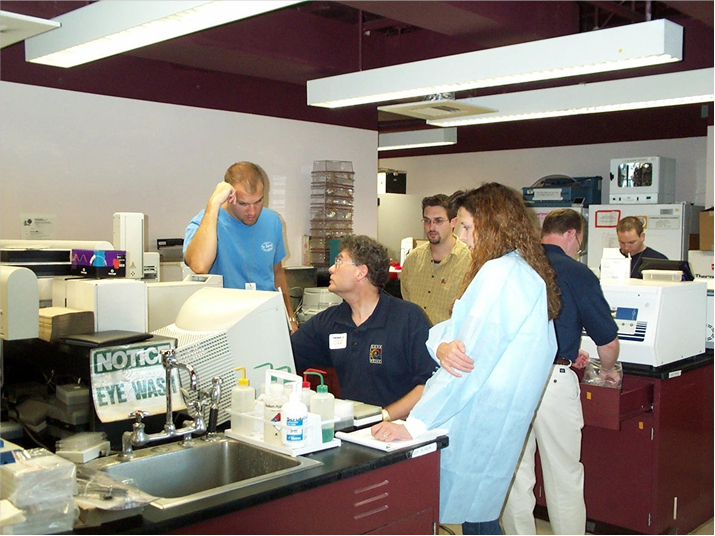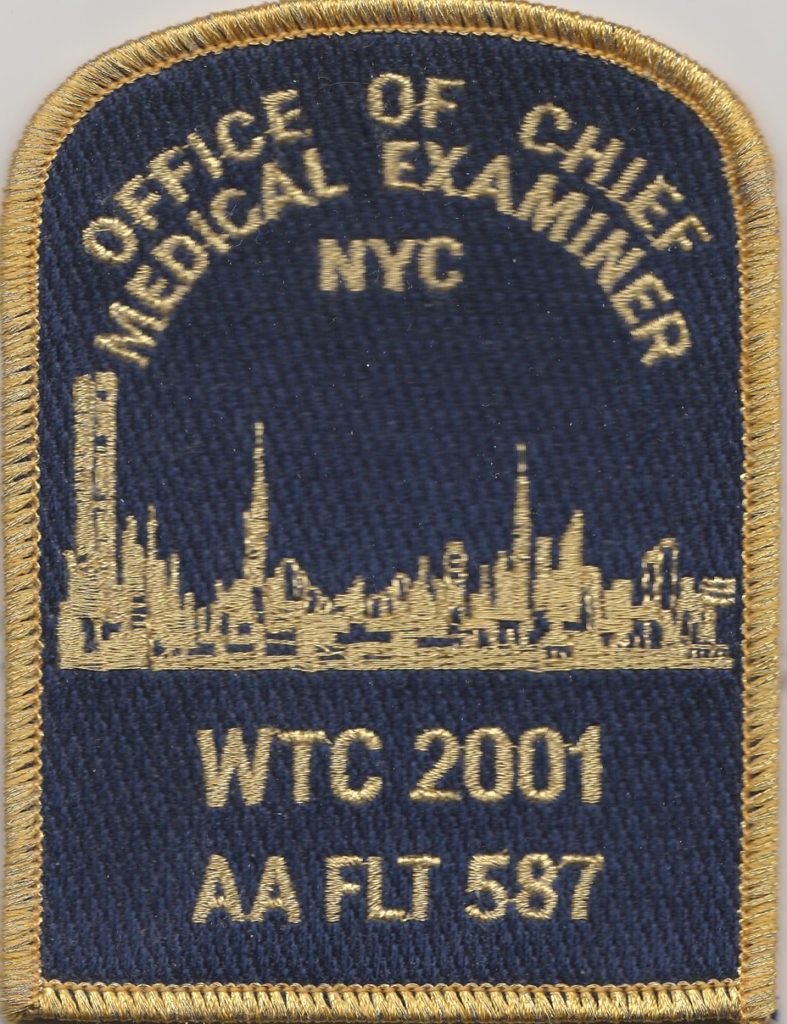
In the summer of 2000, Promega research scientist Allan Tereba was asked to develop an automated protocol for purifying DNA for forensics. His team had recently launched DNA IQ, the first Promega kit for purifying forensic DNA using magnetic beads. This was before the Maxwell® instruments, and before Promega purification chemistries were widely adaptable to high-throughput automation.
“I had my doubts about being able to do that,” Allan says. “When you’re working with STRs, small amounts of contaminant DNA are going to mess up your results. But I went ahead and tried it, and it was a challenge.”
A little over a year later, Allan was in his office when he heard on the radio that a plane had struck the North tower of the World Trade Center in New York City. Shortly after, he heard the announcement that a second plane had hit the South tower.
By that point, Allan and his colleagues had successfully adapted DNA IQ to be used on the deck of a robot. Within days of the attacks, Promega scientists were supporting the New York City Office of Chief Medical Examiner (OCME) and New York State Police in their work to identify human remains that were recovered from Ground Zero.
Thanks to the work of Allan and many other Promega scientists, Promega was prepared to offer unique solutions to urgent needs. In their own words, here are some of those scientists’ reflections.
Automating Forensic DNA Purification
Allan Tereba, Sr. Research Scientist*: In late 2000, my boss came up to me and said “I want you to put DNA IQ on a robotic system.” And I sort of said “Well, that’s going to be difficult. I think at that time, there were some robotic systems that would purify DNA, but they were only for reference samples. We had to design a magnet to fit right on the 96-well plates. I had to spend time learning how to program robots, though the hardest thing was if that if you wanted to get the DNA off the beads, you had to heat it and shake it really hard. I was afraid, because it was a very big risk, but it actually worked pretty well. I used deep well plates and a fairly small amount of liquid. I did some experiments and did some PCR testing to see if there was any cross-contamination, and I saw nothing on controls. That was the point when I said “Boy, it could work.”
In early 2001, after refining the protocol, Allan and several other Promega scientists collaborated with a crime lab in Virginia to test the automated system.
I flew out there and set up the system. We showed them how everything worked and when it got to the shaking part their eyes went wild and they said, ‘This isn’t going to work.’ We told them just to work up their samples, and I went back to Promega. And when they worked everything up, their blanks were perfectly blank.
Paraj Mandrekar, Research Scientist*: In August and early September 2001, I was doing research into isolating DNA from small pieces of tissue. I was doing it manually, but in a way that could be adapted to the robot. And I remember thinking ‘I don’t know why we would ever do that,’ but I could do pieces of tissue on the robot, like 88 at a time. And then a week and a half later, people were like “Hey, were you playing around with pieces of tissue on a robot? Because I think that’s what we need right now…”
On September 11, 2001, Arni Masibay was working in his home office in Florida when he heard the news about the attacks. After the initial shock wore off, Arni realized that Promega was in a unique position to support some of the work that would need to happen in the aftermath.
Arni Masibay, Forensic Regional Account Manager: It popped into my mind that they were going to have to collect and gather all the samples – treating it as a crime scene – and I didn’t know how much they would have to do, but that was one of the challenges I identified right away where Promega could be helpful. At the time, I was very aware of the current projects the GI research scientists were working on, and one of those things was automation. So I tried to contact the NYC Office of the Chief Medical Examiner. The person who answered was a lab director who I hadn’t talked to before, but when I was explaining what I wanted to do, I distinctly remember him saying “I’m the person you need to talk to.”
Michelle Mandrekar, Research Scientist: Before they would test it, we needed to show that [DNA IQ] could purify mitochondrial DNA in case it was a degraded sample, either from the immediate collapse or the time until it was collected. I had primers for these conserved sequences across mammals, so a few days after 9/11, Paraj and I were in the lab on a Saturday doing the PCR to show that we could extract mitochondrial DNA. We were able to show that this mitochondrial sequence could be detected in the DNA IQ samples. It was really rewarding to be able to do something. Everyone’s looking at each other going, “What do we do?” We actually got to be in the lab and we got to do something that could help people.
Identifying 9/11 Victims
On September 17, 2001, a group of Promega scientists including Allan Tereba and Arni Masibay flew to New York City to set up automated DNA purification from human remains at the Office of Chief Medical Examiner (OCME).
Seven days later, Bob McLaren joined the group when they flew to Albany, NY where the New York State Police was preparing to process reference samples from missing persons.
Arni Masibay: We were one of the first flights to go into New York. When I was on the plane, I recall a strange feeling because it was so quiet. And then when we landed, everyone was clapping, and you could almost reel the relief on the plane.

Allan Tereba: There were soldiers everywhere, and we had to go through three checkpoints. They’d ask us, “Why are you here? Why do you want to go in?” They went through our luggage, our packs, everything. We went to the building where the OCME was located and we programmed the robotic systems they had set up. It was an exhausting time. We were working 12-hour days, probably more, and then going back and writing down what we had done.
Paraj Mandrekar: My job shifted towards doing experiments on the Promega campus and then communicating that out to the field. For example, one of the issues was a lot of tissue samples weren’t dissolving under the conditions they were using. So we set up the experiment on-site and then fired off emails and updates with what was working and what wasn’t working.
Allan Tereba: But that’s not the end of the story. When you’re trying to identify samples, you also need reference samples. There was New York State Police lab in Albany that was working with toothbrushes, combs, other objects. And we flew up there to set up another set of robotic systems.
Bob McLaren, Technical Services Scientist*: One of the things I’ll remember forever is when we walked in, there was a robot set up, and we were going to do our programming, but all around the lab were brown paper bags, and all those bags had people’s names. Those were the reference samples for the people who were missing. That kind of hit home – this is people’s lives. People who are no longer with us. So, you’re mindful of that when you walk in the lab. You know that’s what you’re here to do. I’ll remember that sight forever.
Twenty years later, OCME is still working to identify remains recovered from the World Trade Center, using the latest in DNA identification technology.
As we remember the events of September 11, 2001 and honor the memories of those who lost their lives, we send our gratitude to all of the scientists whose work laid the foundation for DNA identification technologies, and all those who remain committed to pushing those technologies even further.
*Job titles reflect positions held in 2001.
Allan Tereba retired from Promega in 2006.
Paraj Mandrekar is now a Technical Services Scientist.
Bob McLaren is now a Sr Research Scientist.
Mark Desire, Assistant Director of the New York City Office of Chief Medical Examiner, will deliver the keynote address at the 32nd International Symposium on Human Identification (ISHI). His presentation will speak to the hardship and perseverance of OCME forensic scientists and families of World Trade Center victims, as well as ongoing work to identify all who lost their lives that day. A panel will also discuss advances in forensic science worldwide that have resulted from two decades of the 9/11 investigation. Register for the conference at ishinews.com.
To learn more about advances in forensic DNA analysis, check out our recent article, The Stories in the Bones: DNA Forensic Analysis 20 Years after 9/11
Latest posts by Jordan Villanueva (see all)
- Tackling Undrugged Proteins with the Promega Academic Access Program - March 4, 2025
- Academic Access to Cutting-Edge Tools Fuels Macular Degeneration Discovery - December 3, 2024
- Novel Promega Enzyme Tackles Biggest Challenge in DNA Forensics - November 7, 2024
